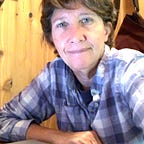Six blue jays hopped from branch to branch in a pine tree on Magnolia Avenue near the Gulf of Mexico beach.
Overhead, three crows circled.
Unseen, a cardinal sang a cheery tune.
Why might scientists care about my observations made on a recent Saturday morning on Florida’s west coast?
The numbers alone might raise questions about the strength of a species, changes in habitat and pollution levels.
Consider how observations helped Rachel Carson, in 1962’s “Silent Spring” — one of the most influential books in the modern environmental movement — demonstrate the disastrous environmental effects of pesticides in the 1950s and 1960s.
A passage in the chapter titled “No Birds Sing” reports a wealth of bird life in a community and then, after several years of spraying DDT on trees, “the town is almost devoid of robins and starlings; chickadees have not been on my shelf for two years, and this year the cardinals are gone, too.”
The chapter also includes observation from a man whose picture window “used to frame a scene splashed with the red of 40 or 50 cardinals and crowded with other species” but, after pesticide spraying, the man seldom saw more than two birds.
We learn from such observations and scientists learn from such observations, as well as their own studies.
What if I see six blue jays many mornings and then they disappear?
What if the population of three crows grows to 300 crows?
What if I hear one cardinal but I used to hear a dozen?
What if one morning I see an ivory-billed woodpecker and prove the bird is not extinct — or no longer extinct?
With this enthusiasm, I approach the global Great Backyard Bird Count, which will be conducted Feb. 18–21. Birders of all ages and skills participate in the four-day annual happening that I consider a Valentine’s Day event for nature lovers.
Here are the steps to conducting the count:
Step 1: Decide where you will watch birds.
Step 2: Watch birds for 15 minutes or more, at least once Feb. 18–21.
Step 3: Count all the birds you see or hear within your planned time and location.
Step 4: Use the Merlin Bird ID app, eBird Mobile app or the eBird website to track your birds.
During the 2020 count, birdwatchers in more than 100 countries turned in nearly 250,000 lists of birds, identifying nearly 7,000 bird species.
During the 2021 count, more than 300,000 participants in 190 countries identified 6,436 species of birds, filed 379,726 ebird checklists and recorded 479,842 Merlin Bird IDs.
With participation in all 50 states, D.C. and five territories, the United States birdwatchers filed more than 250,000 checklists.
Canadian participants submitted more than 43,000 checklists.
Participants in Colombia reported the most bird species — 1,167 species of the country’s 1,826 total known species.
The Great Backyard Bird Count began in 1998 and continues with the support of the Cornell Lab of Ornithology, National Audubon Society and Birds Canada, which joined the project in 2009.
Interested in participating?
For those interested in participating, a webinar will be conducted at 2 p.m. Feb. 16. An announcement on birdcount.org invites you to join “experts as we brush up on bird ID, unlock the mystery of bird songs and practice counting birds no matter how large the flock or busy the feeder. This webinar is designed for birders of all ages and experience — you’ll leave confident and ready to be part of the GBBC!”
